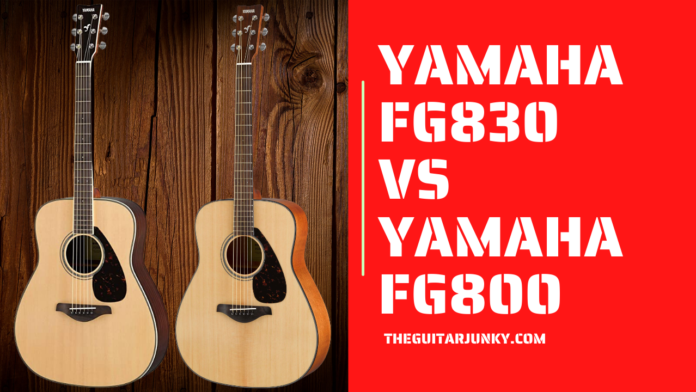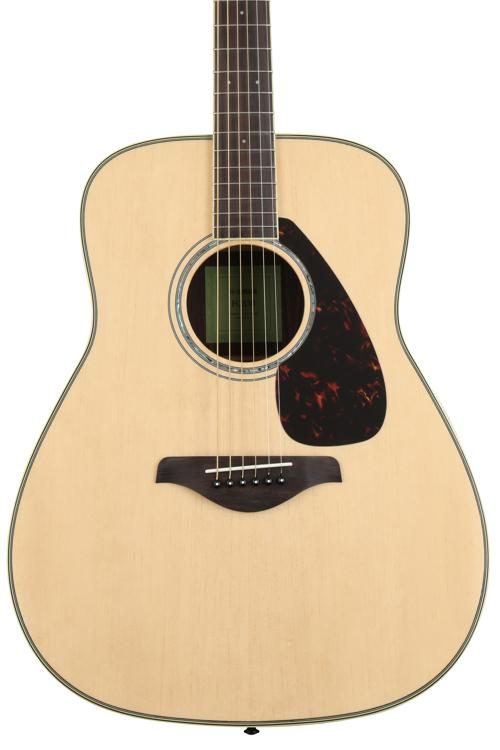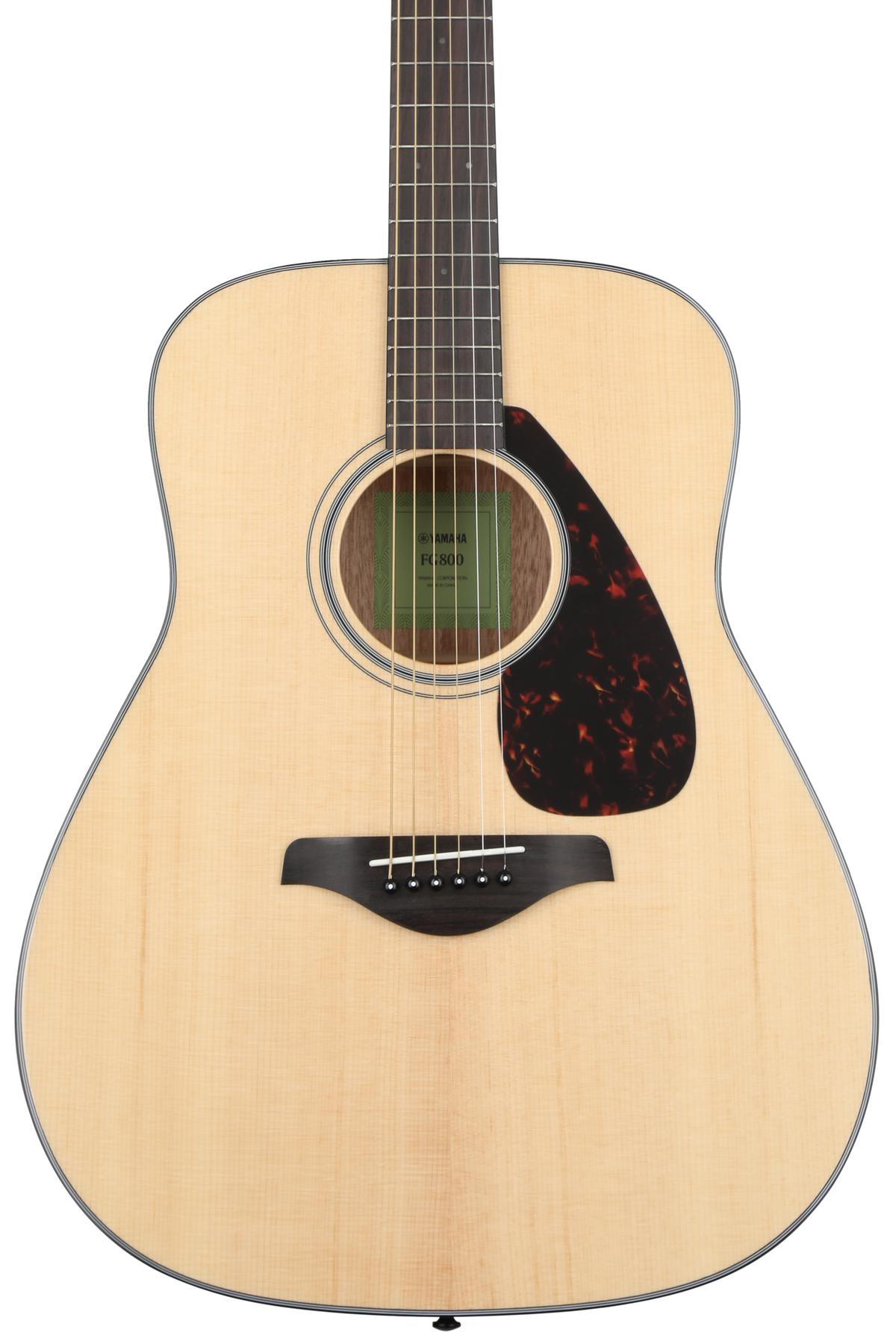Yamaha’s FG700 series is one hell of an acoustic guitar. Now, imagine upgrading this guitar and you’ll now have the FG800 which is really phenomenal.
And today, we are going to look into two guitars from this series, the Yamaha FG830 and Yamaha FG800. Let’s see who wins.
Editor's Choice | Runner Up |
Top: Solid Cedar | Top: Solid Spruce |
Back and Sides: Laminated Wild Cherry | Back and Sides: Rosewood |
Fingerboard: Rosewood | Fingerboard: Rosewood |
Contents
Yamaha FG800
The Yamaha FG800 is the direct successor to the Yamaha FG700s. Both of these guitars are made from the same materials(solid sitka spruce top, nato back and sides, nato neck, rosewood bridges). But the only difference is the internal bracing. The FG800 features an enhanced internal bracing which makes the guitar produce a fuller and defined sound.
Yamaha FG830
On the other hand, here’s another guitar that also has almost the same features with the Yamaha FG800. It also has an enhanced internal X-bracing.
One thing that sets the FG830 guitar apart from the Yamaha FG800 is wood material on the back and sides. While the FG800’s back and sides are made from the standard nato wood, the FG830 on the other hand is made from rosewood.
Rosewood VS Nato
Rosewood material on a guitar produces a warm and dark tone at the same time, with a nice sustain.
On the other hand, Nato material produces a brighter tone, a faster response, though with less sustain.
Advantages Over Each Other
Yamaha FG830
- Nice chimey tones from the rosewood material
- Great design
- Comes in different finishes
- Dark and warm tone with long sustain
Yamaha FG800
- Bright sound from the nato material
- Straightforward and plays great right out of the box
How Does Each Guitar Sound?
Yamaha FG800
As the cliche goes, “less is more.” And this is what this guitar is all about. Though it only comes in a natural finish, it overly compensates on the sound. The Yamaha FG800 is a straightforward acoustic guitar that sounds awesome right out of the box.
This is an overall great acoustic guitar, though there are some things that makes us prefer the 830. The FG800 only comes in one finish, which can be a bummer if you want to choose among a variety of finishes. Next is the sustain. Nato is a common wood material among guitars which makes it cheaper than the Yamaha FG830, which is made from rosewood.
Having said that, it also has less sustain compared to the FG830.
Yamaha FG830
We have to choose the Yamaha FG830 because it just dominates the FG800, overall.
Let’s get into the aesthetics first. The white binding around its body looks awesome – who wouldn’t love that?
Next is the sound. Rosewood is an exotic type of wood material, which makes it more expensive than Nato. It produces a dark, warm tone, and a long sustain. In its the price range, you would not find any other rosewood guitars that are greater than this which makes the Yamaha FG830 worthy of its price.
Conclusion
This is one of the toughest decisions that I have to make. Choosing between Yamaha FG800 vs Yamaha 830 can be difficult. Each is made from exactly the same material except for the side materials. Each guitar almost sounds the same, with only a slight difference.
However, there should only be one winner and it’s the Yamaha FG830.
Did you find this Yamaha FG830 vs FG800 review useful? Let us know by leaving your comments below.







correct the back/sides wood mention for the FGX800C …. not rosewood.
Hi Doug, thanks for noticing it. Fixed!
Hi, thanks for your review. But just wanted to let it know that the FG800 does come in at least two finishes, I just bought one and they have it in natural ou matte.
My view is that you do point out the plus points of both guitar models, however, most every article I read both from retailers and reviewers, glaringly omits the following:
The FG830 has “laminated” Rosewood sides. This is confirmed by Yamaha technical.
It is therefore questionable as to how much difference a veneer ( ask how thick the rosewood part of the side and back are as part of the total thickness) would make to the overall sound.
Of course layers/ a layer of varnish, adds to the thickness and thereby as an effect on the tone.
As you correctly point out, the FG 800m produces a bright clarity and why would it not! It’s solid, and set if up correctly, lower action and bridge nut adjustment, truss rod etc, will give that resonance and greater boom, that higher priced guitars give. This should be especially helpful to the less experienced or starter player.
I personally don’t feel feel, that there is a lot more there, rather than an extremely pretty guitar that adds so much more value as the basic guitar remains just that.
As matter of fact, very clever Yamaha techniques wrong every ounce of sound and value from every price point, they produce a very good product.
I have the FS800, just got it yesterday. It amazed me, I really expected to be disappointed. Even though I have, in the past, owned several Yamahas on the low end and they were wonderful, I thought 200$ today would yield very little of that experience. Wrong! I lowered the bridge saddle.. that’s all it took. Action is creamy soft and tone and volume are just fine. The low end is a little lacking.. that’s why I’m here. I want to return this fantastic guitar..and get the FG830 which I hope gives me the low end I’m searching for. I disagree with the idea that laminated rosewood will somehow lose all of it’s tonal properties.. especially comparing to other laminated woods. I have owned many guitars, breedlove martin taylor, and one of the best of them was an Alvarez with laminated rosewood sides and back. It depends as much on the actual guitar as the materials, often, and dramatically. This article helped me make my decision to get the FG830, yet I can still only hope that, blind, I wind up with one as good as the FS800 I have already.